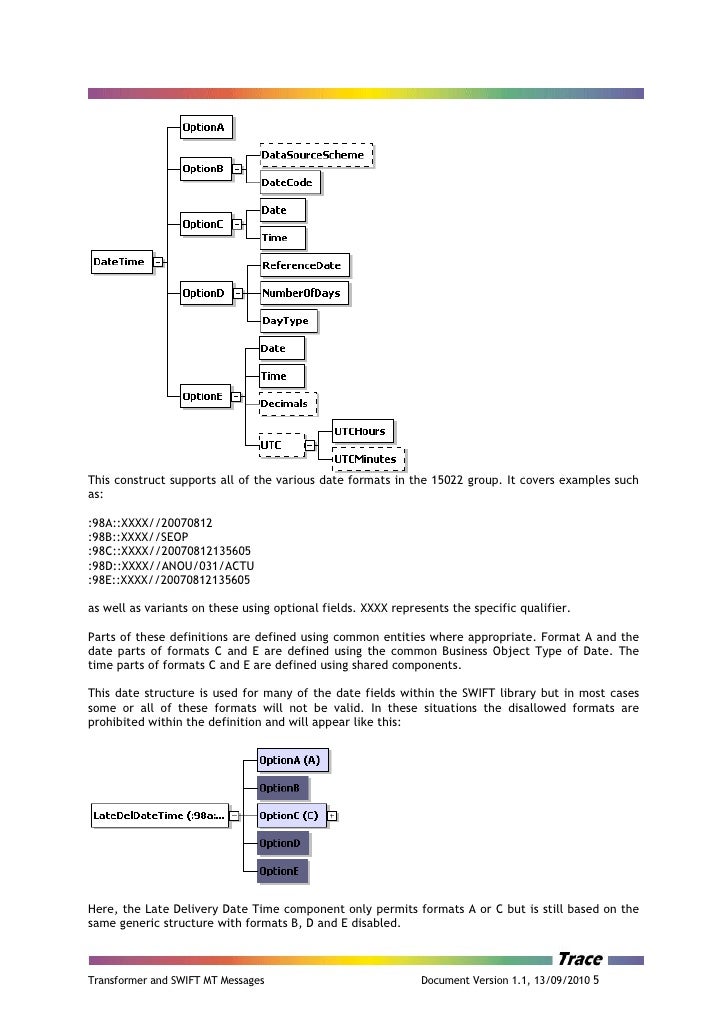Overview SwiftDate exposes several convenient functions to print (and parse, of course) dates and time intervals as strings: as custom string defined by tr35-31format; for example 'yyyy-MM-dd'for '2015-01-05' as ISO8601strings with all available sub specs.
SWIFT message types are the format or schema used to send messages to financial institutions on the SWIFT (Society for Worldwide Interbank Financial Telecommunication) network. The original message types were developed by SWIFT and a subset was retrospectively made into an ISO standard, ISO 15022. In many instances, SWIFT message types between custodians follow the ISO standard.[1] This was later supplemented by a XML based version under ISO 20022.
Composition of MT number[edit]
Swift Date From String
SWIFT messages consist of five blocks of data including three headers, message content, and a trailer. Message types are crucial to identifying content.
All SWIFT messages include the literal 'MT' (message type). This is followed by a three-digit number that denotes the message category, group and type. Consider the following two examples.
Example 1

Swift Date formatting and String to Date Conversion The DateFormatter class is a subclass of the Formatter abstract class that can be used to convert a Date object into a human-readable string. It can also be used to convert a String representation of a date into a Date object. Working with the SWIFT community, SWIFT Standards operates the annual maintenance process for MT, which ensures that the standard evolves to meet changing market needs. SWIFT Standards, under contract to ISO, also maintains two open messaging standards: ISO 15022, which is used for securities settlement and asset servicing, and ISO 20022, which.
MT304
- The first digit (3) represents the category. A category denotes messages that relate to particular financial instruments or services such as precious metals (6), treasury (3), or traveller's cheques (8). The category denoted by 3 is treasury markets
- The second digit (0) represents a group of related parts in a transaction life cycle. The group indicated by 0 is a financial institution transfer.
- The third digit (4) is the type that denotes the specific message. There are several hundred message types across the categories. The type represented by 4 is a notification.
A MT304 message is considered an 'Advice/Instruction of a Third Party Deal' and it used to advise of or instruct the settlement of a third party foreign exchange deal. [2] For example, an asset manager who executed a FX transaction with a broker would send a MT304 instruction to the custodian bank of the client.
Example 2
Swift Date Timezone

- The first digit (1) represents the category. The category denoted by 1 is customer payments and cheques.
- The second digit (0) represents a group of related parts in a transaction life cycle. The group indicated by 0 is a financial institution transfer.
- The third digit (3) is the type that denotes the specific message. There are several hundred message types across the categories. The type represented by 3 is a notification.
A MT103 message is considered a 'Single Customer Credit Transfer' and is used to instruct a funds transfer.[3]
Overview of SWIFT MT categories[edit]
The table below shows the different categories and the message type descriptions.
| Category | Message type | Description | Number of message types |
|---|---|---|---|
| 0 | MT0xx | System messages | - |
| 1 | MT1xx | Customer payments and cheques | 19 |
| 2 | MT2xx | Financial institution transfers | 18 |
| 3 | MT3xx | Treasury markets | 27 |
| 4 | MT4xx | Collection and cash letters | 17 |
| 5 | MT5xx | Securities Markets | 60 |
| 6 | MT6xx | Treasury markets – metals and syndications | 22 |
| 7 | MT7xx | Documentary credits and guarantees | 29 |
| 8 | MT8xx | Traveller's cheques | 11 |
| 9 | MT9xx | Cash management and customer status | 21 |
ISO 15022 MT[edit]
Although ISO 15022 message types are different in their structure than the SWIFT MT, the naming convention remains the same.
See also[edit]
- ISO 9362 (standard format for SWIFT IDs)
External links[edit]
- Message standards supported by the SWIFT network: 'Standards MT & MX Equivalence Table'(PDF). SWIFT. 28 July 2017.
- Message types defined in ISO15022 'ISO15022 Data Field Dictionary - Index of Messages'. ISO.
References[edit]
- ^McGill, R.; Patel, N. (2008). Global Custody and Clearing Services. Basingstoke, Hampshire: Springer. p. 27. ISBN9781349282883.
- ^'List of all SWIFT Messages Types'. Paiementor. Retrieved 2020-01-07.
- ^'List of all SWIFT Messages Types'. Paiementor. Retrieved 2020-01-07.
Ios Date Formatter
Working with NSDate, NSDateFormatter, and NSDateComponents can be a little convoluted, so I’ve created myself a cheat sheet that will be updated as I discover new tips and tricks in this realm.

The new cheat sheet can be found over at GitHub in the form of an Xcode Playground:
- Swift Dates Cheat Sheet Playground

Topics that are included in the Playground are as follows:
- Getting today’s date
- Converting
NSDatetoString - Converting
StringtoNSDate - Getting components of an
NSDate - Setting components of an
NSDate - Creating new
NSDateinstances fromNSDateComponentinstances
The best way to view this cheat sheet is by downloading the playground from GitHub, but here’s a straight copy-paste from the repo in case you just want to copy and paste it into a playground of your own from here:
- Parse PFCloud – “JSON text did not start with array or object”
- Working with Swift: Adopt a Protocol or Pass a Function?
- Listing Calendar Events with Event Kit and Swift
- Adding Buttons to the Navigation Bar with Storyboards
- FIX – Query in Parse Cloud Code Returns Unauthorized Error